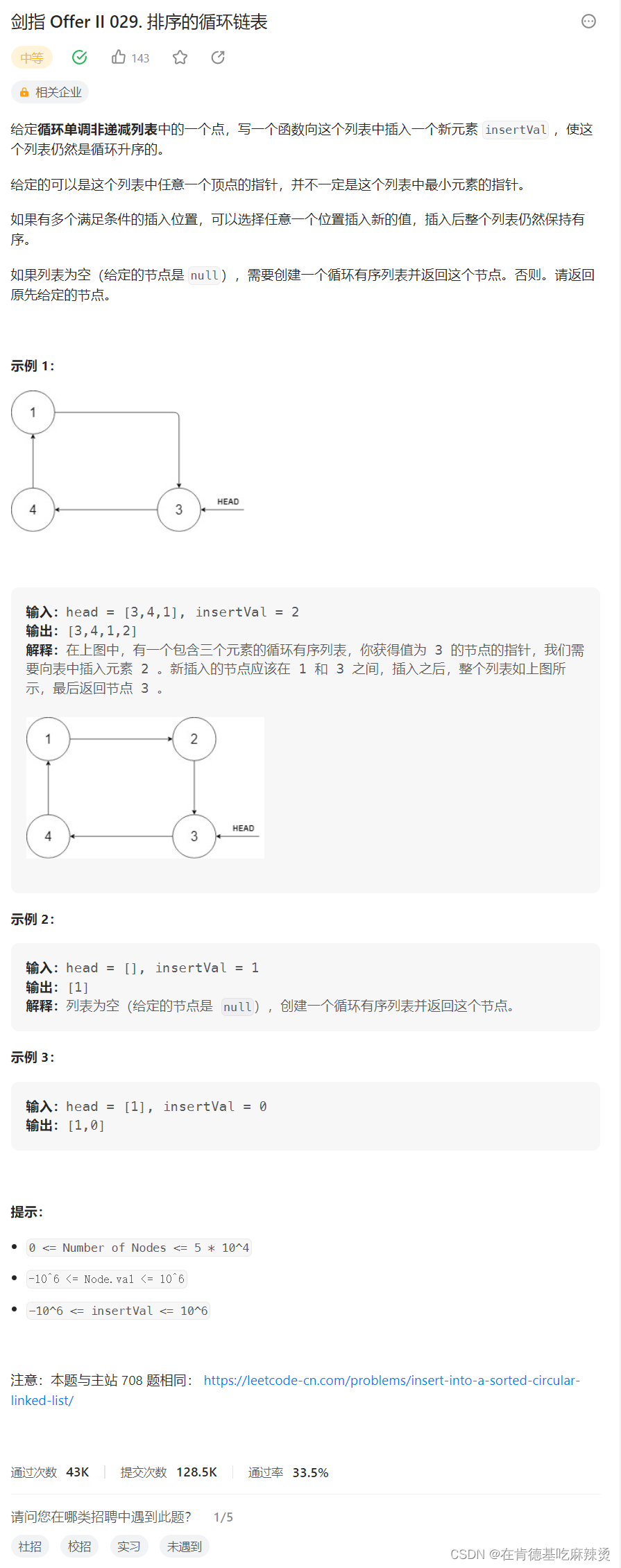当前栏目
【Leetcode——排序的循环链表】
😊😊😊
一、力扣题之排序循环链表
题目如下:航班直达!!

二、解题思路
刚看到直到题我还是很迷的,没有写过类似的题目。
当我看到官方题解时,嘿嘿嘿三个字形容此时的心情。
首先需要知道,这道题是升序的,但是当我们找到最大节点时,最大节点的next是最小节点,这是循环链表的缘故
1. 使用双指针法
双指针在链表这块题目还是特别特别好用的。
定义一个cur指针指向头节点,next指针指向头节点的下一个节点,这是初始状态。
这里需要分几种情况来讨论,拿题目的样例来看:

对插入数据的大小不同,分为几种情况:
1)当 insertVal大于cur的值,并且insertVal小于next的值时,
此时insertVal介于cur和next之间,插入它们之间即可。
2)当insertVal大于cur的值,并且cur的值大于next的值时,
此时cur是链表中的MAX节点,next是链表中的MIN节点。
而insertVal大于MAX节点,所以只需在cur和next之间插入即可。
3)当cur大于next的值,表明cur是MAX节点,next是MIN节点,并且insertVal的值小于next的值,此时insertVal小于MIN,只需在cur和next之间插入即可。
以上三种情况:都是在cur和next之间插入。
4)而如果链表为空,更容易了,题目也已经给出,如果链表为空,只需要返回插入的节点即可。
Node*insertnode = (Node*)malloc(sizeof(Node));
insertnode->val = insertVal;
insertnode->next = NULL;
//链表为空
if(head == NULL)
{
insertnode->next = insertnode;
return insertnode;
}
5)如果链表只有一个节点,那么也不用遍历了,在head后面插入即可,一定是有序的。
//只有一个节点
if(head->next == head)
{
insertnode->next = head;
head->next = insertnode;
return head;
}
对于链表中的节点全部相同的情况,在哪里插入都可以,这种情况已经包含在上面三种情况的一种处理了,无需再单独处理。
总代码如下:
typedef struct Node Node;
struct Node* insert(struct Node* head, int insertVal) {
Node*insertnode = (Node*)malloc(sizeof(Node));
insertnode->val = insertVal;
insertnode->next = NULL;
//链表为空
if(head == NULL)
{
insertnode->next = insertnode;
return insertnode;
}
//只有一个节点
if(head->next == head)
{
insertnode->next = head;
head->next = insertnode;
return head;
}
//两个节点及以上
struct Node*cur = head,*next = head->next;
while(next!=head)
{
//以下三种情况都是在cur和next之间插入
if(cur->val<=insertVal && insertVal<=next->val)
{
break;
}
else if(cur->val<=insertVal && cur->val>next->val)
{
break;
}
else if(cur->val>next->val && insertVal<=next->val)
{
break;
}
cur = next;
next = next->next;
}
insertnode->next = next;
cur->next = insertnode;
return head;
}
2、找出最大节点,最大节点的下一个节点是最小节点,由此展开讨论
第一步1)先找出最大节点,最大节点的下一个节点是最小节点,分别记录下来。
第二步2)分情况讨论:情况与第一种方法差不多,唯一不同的是:
1、当insertVal大于最小值,并且insertVal小于最大值,此时需要从最小的节点开始遍历,直到找到第一个节点的val值大于insertVal,在该节点前面插入即可。
2、当insertVal大于cur的值,并且cur的值大于next的值时,
此时cur是链表中的MAX节点,next是链表中的MIN节点。
而insertVal大于MAX节点,所以只需在cur和next之间插入即可。
3、当cur大于next的值,表明cur是MAX节点,next是MIN节点,并且insertVal的值小于next的值,此时insertVal小于MIN,只需在cur和next之间插入即可。
同样,需要在前面考虑空链表的特殊情况,而一个节点的特殊情况下面可以处理。
struct Node* insert(struct Node* head, int insertVal)
{
Node*insertnode = (Node*)malloc(sizeof(Node));
insertnode->val = insertVal;
insertnode->next = NULL;
//特殊情况
if(head == NULL)
{
insertnode->next = insertnode;
return insertnode;
}
//1.找到最大节点
Node*maxnode = head, *cur = head,*next = head->next;
int max = head->val;
while(next!=head)
{
if(max<=next->val)
{
max = next->val;
maxnode = next;
}
cur = next;
next = next->next;
}
//找到最大节点了
//最大节点的next就是最小节点
Node*minnode = maxnode->next;
//2.分情况讨论
//1)如果insertnode的val大于最大的或者小于最小的,则插入点在最大和最小节点之间
if(insertVal>=maxnode->val || insertVal<=minnode->val)
{
insertnode->next = minnode;
maxnode->next = insertnode;
return head;
}
//2)如果介于最大和最小节点之间,则从最小节点开始遍历
//直到找到第一个比insertnode大的节点
cur = minnode;
next = minnode->next;
while(next->val<insertVal)
{
cur = next;
next = next->next;
}
//找到了
insertnode->next = next;
cur->next = insertnode;
return head;
}
总结
第一次做到循环排序链表的题,爽歪歪,写起来很舒服,链表的题需要勤快画图分析,分析二十分钟,写代码十分钟。
相关文章
- 前端面试 【JavaScript】— typeof 是否能正确判断类型?
- 前端面试 【JavaScript】— instanceof 能否判断基本数据类型?
- 前端面试 【JavaScript】— 能不能手动实现一下 instanceof 的功能?
- 前端面试 【JavaScript】— Object.is和=== 有什么区别?
- 前端面试 【JavaScript】— JS中类型转换有哪几种?
- 前端面试 【JavaScript】— == 和 ===有什么区别?
- 前端面试 【JavaScript】— 对象转原始类型是根据什么流程运行的?
- JavaScript 的 parseInt() 函数
- javascript实现两个数字进行组合
- JS监听键盘按键
- 大前端开发中的路由管理之五:Flutter篇
- Javascript的DOM操作
- 在Vue项目中使用WebSocket技术
- 新手向:前端程序员必学基本技能——调试JS代码
- React 毁了 Web 开发!
- 「JS 逆向百例」cnki 学术翻译 AES 加密分析
- 商标注册域名后缀用什么?商标和域名有哪些区别?
- 网站建设流程是怎样的?需要看重哪些细节?
- 网站域名商标注册流程是什么?网站域名商标有什么用?
- 如何建设一个实用性强的网站 网站上线后如何运营

